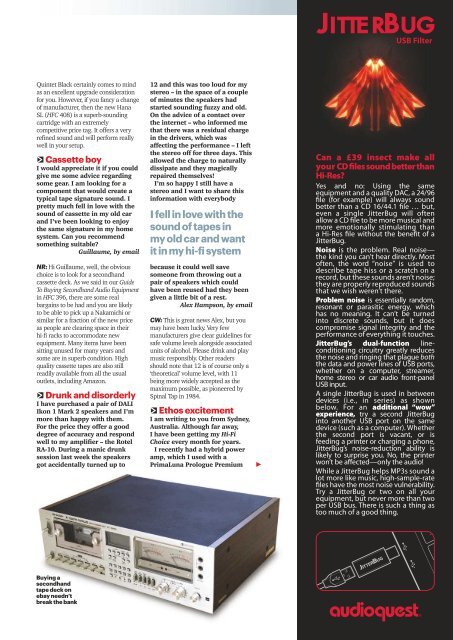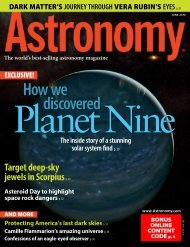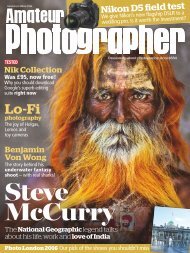Create successful ePaper yourself
Turn your PDF publications into a flip-book with our unique Google optimized e-Paper software.
JITTERBUG<br />
USB <strong>Fi</strong>lter<br />
Quintet Black certainly comes to mind<br />
as an excellent upgrade consideration<br />
for you. However, if you fancy a change<br />
of manufacturer, then the new Hana<br />
SL (HFC 408) is a superb-sounding<br />
cartridge with an extremely<br />
competitive price tag. It offers a very<br />
refined sound and will perform really<br />
well in your setup.<br />
Cassette boy<br />
I would appreciate it if you could<br />
give me some advice regarding<br />
some gear. I am looking for a<br />
component that would create a<br />
typical tape signature sound. I<br />
pretty much fell in love with the<br />
sound of cassette in my old car<br />
and I’ve been looking to enjoy<br />
the same signature in my home<br />
system. Can you recommend<br />
something suitable?<br />
Guillaume, by email<br />
NR: <strong>Hi</strong> Guillaume, well, the obvious<br />
choice is to look for a secondhand<br />
cassette deck. As we said in our Guide<br />
To Buying Secondhand Audio Equipment<br />
in HFC 396, there are some real<br />
bargains to be had and you are likely<br />
to be able to pick up a Nakamichi or<br />
similar for a fraction of the new price<br />
as people are clearing space in their<br />
hi-fi racks to accommodate new<br />
equipment. Many items have been<br />
sitting unused for many years and<br />
some are in superb condition. <strong>Hi</strong>gh<br />
quality cassette tapes are also still<br />
readily available from all the usual<br />
outlets, including Amazon.<br />
Drunk and disorderly<br />
I have purchased a pair of DALI<br />
Ikon 1 Mark 2 speakers and I’m<br />
more than happy with them.<br />
For the price they offer a good<br />
degree of accuracy and respond<br />
well to my amplifier – the Rotel<br />
RA-10. During a manic drunk<br />
session last week the speakers<br />
got accidentally turned up to<br />
12 and this was too loud for my<br />
stereo – in the space of a couple<br />
of minutes the speakers had<br />
started sounding fuzzy and old.<br />
On the advice of a contact over<br />
the internet – who informed me<br />
that there was a residual charge<br />
in the drivers, which was<br />
affecting the performance – I left<br />
the stereo off for three days. This<br />
allowed the charge to naturally<br />
dissipate and they magically<br />
repaired themselves!<br />
I’m so happy I still have a<br />
stereo and I want to share this<br />
information with everybody<br />
I fell in love with the<br />
sound of tapes in<br />
my old car and want<br />
it in my hi-fi system<br />
because it could well save<br />
someone from throwing out a<br />
pair of speakers which could<br />
have been reused had they been<br />
given a little bit of a rest.<br />
Alex Hampson, by email<br />
CW: This is great news Alex, but you<br />
may have been lucky. Very few<br />
manufacturers give clear guidelines for<br />
safe volume levels alongside associated<br />
units of alcohol. Please drink and play<br />
music responsibly. Other readers<br />
should note that 12 is of course only a<br />
‘theoretical’ volume level, with 11<br />
being more widely accepted as the<br />
maximum possible, as pioneered by<br />
Spinal Tap in 1984.<br />
Ethos excitement<br />
I am writing to you from Sydney,<br />
Australia. Although far away,<br />
I have been getting my <strong>Hi</strong>-<strong>Fi</strong><br />
<strong>Choice</strong> every month for years.<br />
I recently had a hybrid power<br />
amp, which I used with a<br />
PrimaLuna Prologue Premium<br />
Can a £39 insect make all<br />
your CD files sound better than<br />
<strong>Hi</strong>-Res?<br />
Yes and no: Using the same<br />
equipment and a quality DAC, a 24/96<br />
file (for example) will always sound<br />
better than a CD 16/44.1 file … but,<br />
even a single JitterBug will often<br />
allow a CD file to be more musical and<br />
more emotionally stimulating than<br />
a <strong>Hi</strong>-Res file without the benefit of a<br />
JitterBug.<br />
Noise is the problem. Real noise—<br />
the kind you can’t hear directly. Most<br />
often, the word “noise” is used to<br />
describe tape hiss or a scratch on a<br />
record, but these sounds aren’t noise;<br />
they are properly reproduced sounds<br />
that we wish weren’t there.<br />
Problem noise is essentially random,<br />
resonant or parasitic energy, which<br />
has no meaning. It can’t be turned<br />
into discrete sounds, but it does<br />
compromise signal integrity and the<br />
performance of everything it touches.<br />
JitterBug’s dual-function lineconditioning<br />
circuitry greatly reduces<br />
the noise and ringing that plague both<br />
the data and power lines of USB ports,<br />
whether on a computer, streamer,<br />
home stereo or car audio front-panel<br />
USB input.<br />
A single JitterBug is used in between<br />
devices (i.e., in series) as shown<br />
below. For an additional “wow”<br />
experience, try a second JitterBug<br />
into another USB port on the same<br />
device (such as a computer). Whether<br />
the second port is vacant, or is<br />
feeding a printer or charging a phone,<br />
JitterBug’s noise-reduction ability is<br />
likely to surprise you. No, the printer<br />
won’t be affected—only the audio!<br />
While a JitterBug helps MP3s sound a<br />
lot more like music, high-sample-rate<br />
files have the most noise vulnerability.<br />
Try a JitterBug or two on all your<br />
equipment, but never more than two<br />
per USB bus. There is such a thing as<br />
too much of a good thing.<br />
Buying a<br />
secondhand<br />
tape deck on<br />
ebay needn’t<br />
break the bank






